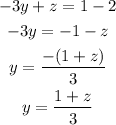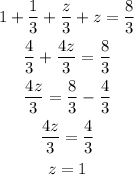ANSWER
• x = 1/3
,
• y = 2/3
,
• z = 1
Step-by-step explanation
There are many methods to solve a linear system of equations, but in this case we have to use the substitution method -which consists in clearing one variable as a function of the other/s and replace in another equation. For a system of three variables such as this one, we have to do this twice:
1° clear x from the first equation:

Replace x by this expression in the second equation:

Note that now we have two variables, y and z. Before the next step we have to rewrite the equation above so that we only have one y:

2° clear y from the equation above:

And replace y by this expression in the last equation. Note that the third equation also contains x, so we have to replace first x as a function of y like in the first step:

Rewrite it so we only se one y:

And now we replace y by the expression we found in the second step:

So now we have one equation with one variable. Let's solve for z:

We have that z = 1.
The next steps are to back replace and find the other variables. Remember that in the second step we had y as a function of z:

Replace z = 1 and solve:

y = 2/3
And finally, replace y = 2/3 in the expression of the first step, where we found x as a function of y:

and we got x = 1/3